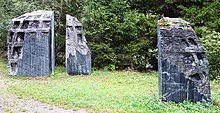Kienburg (municipality of Matrei in East Tyrol)
|
Kienburg ( hamlet ) locality |
||
|---|---|---|
|
|
||
| Basic data | ||
| Pole. District , state | Lienz (LZ), Tyrol | |
| Pole. local community | Matrei in Osttirol ( KG Matrei in Osttirol Land) | |
| Coordinates | 46 ° 55 '37 " N , 12 ° 34' 57" E | |
| Residents of the village | 87 (January 1, 2020) | |
| Post Code | 9971 | |
| Statistical identification | ||
| Locality code | 16826 | |
| Counting district / district | Huben and surroundings (70 717 002) | |
 Kienburg with the courts of Trininger and bubbles |
||
| Source: STAT : index of places ; BEV : GEONAM ; TIRIS | ||
Kienburg is a fraction of the municipality of Matrei in East Tyrol . The village is located in the Iseltal and formed the southernmost village in the municipality of Matrei. Kienburg has 87 inhabitants (as of January 1, 2020).
geography
Kienburg is located in the cadastral community of Matrei in Osttirol Land in the southeast corner of the Matrei municipality. The fraction is located on the slope of the Rudnig between the Gossenbach in the south and the Schwarzach in the north. The Gossenbach forms the border to the municipality of St. Johann im Walde , the Schwarzach the border to the village of Huben . In the east, the Isel separates Kienburg from the municipality of Kals am Großglockner , with the village of Unterpeischlach opposite Kienburg. If you follow the road that leads from Huben over the Isel to St. Johann, you will find the center of the settlement of Kienburg near the confluence of the Schwarzach and Isel at the foot of the Trininger and Blasen farms. If you follow the road in the direction of St. Johann you will come to the Oberbrunner and Unterbrunner farms, which are followed in the southeast by the Kienburg TAL pumping station and the regional sewage treatment plant of the Hohe Tauern Süd sewage association. Further south there is also a group of houses around Kienburg Castle with the former Maierhof Stocker or Kienburger. Some houses in Kienburg are also right on the border with St. Johann, including the Falter farm and the Lauster Steinbau company.
population
For a long time, Kienburg was not shown separately in the censuses. In 1951, Kienburg was still part of Hubens. Kienburg comprised 5 houses and 14 residents, with Kienburg probably meaning the area around the castle ruins. In addition, Trin (the farms in Trininger and bubbles) with 23 residents was expelled from two houses.
Buildings and sights
The most important cultural and historical building in Kienburg is the Kienburg castle ruin of the same name from the second half of the 12th century. There is also a drinking chapel in Trien and a house chapel at the Falter farm.
The house chapel of the Falter farm was built in 1935 and goes back to a promise that Franz Mattersberger made after two of his three sons were killed in the First World War. Mattersberger vowed to erect a wayside shrine if his son returned. After Franz Mattersberger died shortly after the war, his son Alois Mattersberger, who had returned from the war, had a house chapel built instead of a wayside shrine, which was consecrated in 1936. The chapel houses a baroque crucifixion group from the first half of the 18th century, the frescoes depict St. Leonhard and St. Notburga and were made by Josef Defregger.
The drinking chapel is located at the Trininger Hof (Kienburg No. 16) and was consecrated to St. Joseph. The chapel dates from the 18th century and was renewed for the first time in 1847. Further renovations followed at the end of the 19th century, followed by restoration in 1992/93. The two-bay chapel with apse rises above a rectangular floor plan and has a steep, shingle-roofed gable roof. A wooden roof turret with arched sound holes rises above it on the entrance side. The roof turret itself is protected by a high, curved tent roof and is crowned by a ball and cross. The longitudinal walls are pierced by two arched windows, on the entrance side there is the arched main portal, a viewing window and in the gable a bezel and a round window. The interior of the chapel is dominated by the baroque altar from the beginning of the 18th century. It was designed from wood and has a reddish marble frame with gold-plated ornamental parts. The altarpiece shows Saint Joseph with the baby Jesus, in the excerpt there is an oval picture with a representation of Mary with the child.
The natural stone factory Lauster organized a stone carving symposium in the 1990s, the works of which were displayed on the Isel.
Individual evidence
- ↑ Statistics Austria: Population on January 1st, 2020 by locality (area status on January 1st, 2020) , ( CSV )
- ^ Austrian Central Statistical Office (ed.): Local directory of Austria. Edited on the basis of the results of the census of June 1, 1951. Vienna 1953
literature
- Bundesdenkmalamt (Ed.): The art monuments of the political district of Lienz. Part III. Iseltal, Defereggental, Kalsertal, Virgental. Verlag Berger, Horn 2007 ISBN 978-3-85028-448-6 (Austrian Art Topography, Volume LVII)
- Alexander Brugger; Josef Wörgötter: Parish Church of St. Alban. Matrei in East Tyrol. Self-published, Matrei in Osttirol 1984
- Tobias Trost; Alexander Brugger: Matrei in Osttirol. A hike from the Kienburg to the Großvenediger. Edition Anteros, Vienna 2005, ISBN 3-85340-015-9



